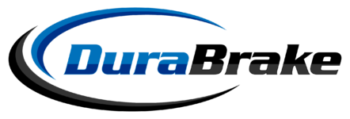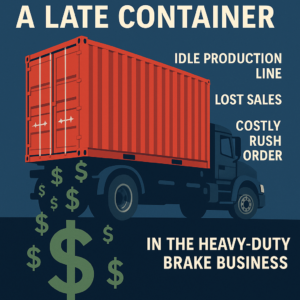In the brake parts industry, timing is everything. Customers depend on DuraBrake for safe, reliable, and readily available components and on-schedule deliveries. But what happens when you order a container of parts expecting it on a certain date, but it shows up months later than expected? The damage goes far beyond a missed delivery date — it ripples across every part of the business.
1. Emergency Procurement at Higher Prices
When the container doesn’t arrive, you can’t simply tell customers to wait. To keep business moving, companies are often forced to procure parts from alternate suppliers — sometimes domestically, sometimes from distributors — at much higher prices than planned. These “stop-gap” purchases eat into margins, create pricing inconsistencies, and can even result in selling at a loss just to keep customers supplied.
2. Lost Sales and Backorders
Brake parts aren’t optional — when vehicles are down, customers expect fast solutions. If parts aren’t available, orders go unfilled, and sales walk out the door. Backorders pile up, frustrating loyal customers who may turn to competitors. Even after the container finally arrives, those lost sales can never be recaptured. In addition, if you don’t have the brake drums you expected, the customer is likely to buy all of their brake products at your competitor at least in the short-term.
3. Customer Trust at Risk
In this business, relationships drive repeat business. Customers rely on consistency. When you can’t deliver, your reliability is called into question. A single late shipment can cause lasting damage to trust — and regaining it often requires discounts, free shipping, or other concessions that further erode profitability.
4. Higher Operating Costs
Late arrivals force businesses to scramble. You may resort to costly freight for urgent parts, pay staff overtime to manage disruptions, or spend hours on customer service calls smoothing over frustrations. These “firefighting” expenses quickly add up.
5. Inventory Whiplash
When the container finally does show up, it often lands all at once. Instead of receiving parts steadily when needed, you’re suddenly flooded with months of stock. Warehousing space becomes limited, cash flow is strained again, and some items may sit idle for some time.
6. Strategic Setbacks
Supply disruptions don’t just affect today’s orders. They slow down new product launches, stall marketing campaigns, and prevent you from meeting the commitments that build your reputation as an industry leader. Opportunities missed due to late containers rarely come back.
7. Cash Flow Frozen in Transit
When a container is ordered, if you are prepaying for inventory, tens of thousands of dollars could be tied up in inventory. If that shipment ships late, sits at sea or at a congested port for months, so does your cash. Meanwhile, overhead costs continue: payroll, rent, utilities, and supplier payments. The capital you counted on converting into revenue remains locked away, hurting liquidity and limiting your ability to invest elsewhere.
The total additional cost of the late container to your business may cost you as much the value of the container you have ordered. And this doesn’t even measure the hardest cost of all: customer trust and loyalty lost in the process.
Final Thoughts
Brake parts keep fleets — and businesses — moving. But in today’s global supply chain, reliable delivery is as important as quality manufacturing. The true cost of late containers is measured not just in dollars, but in trust, opportunity, and growth. For businesses like DuraBrake’s, minimizing those risks is not optional — it’s essential. DuraBrake also must navigate worldwide logistics and containers do get held up at times, but we maintain inventory in our 5 North American warehouses and we only bill you once you receive the goods.


